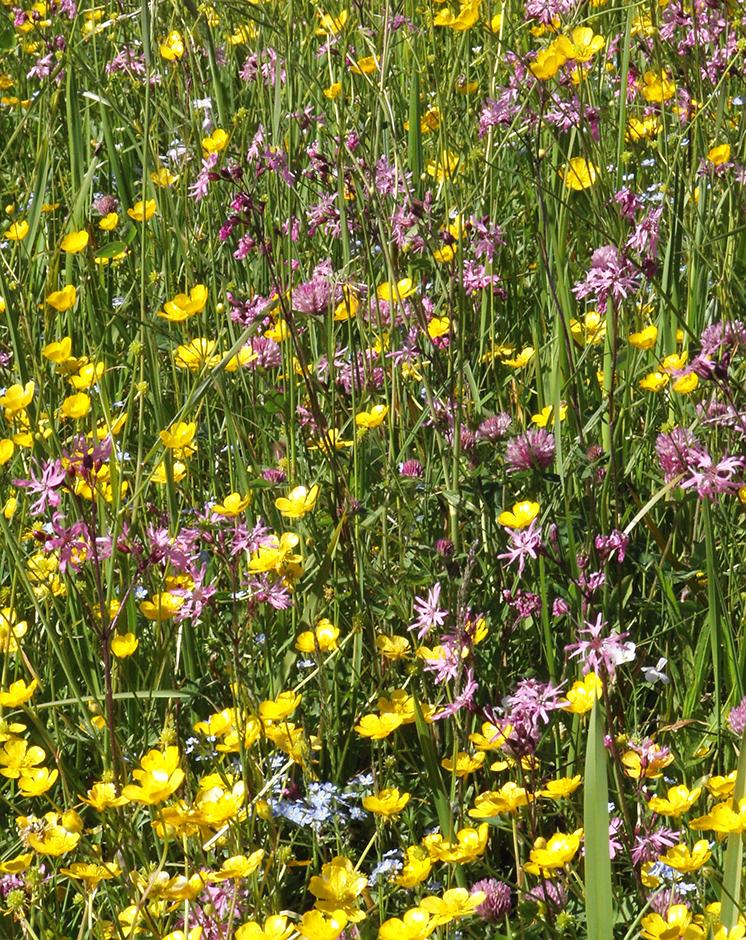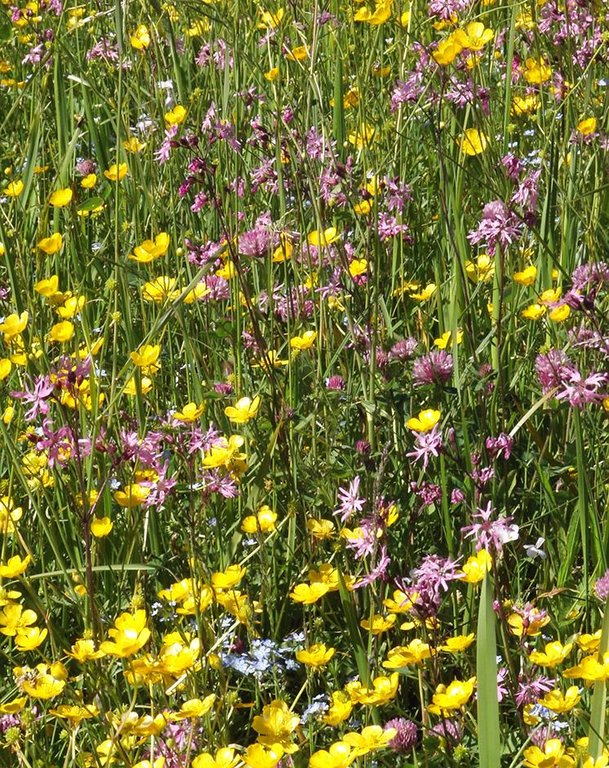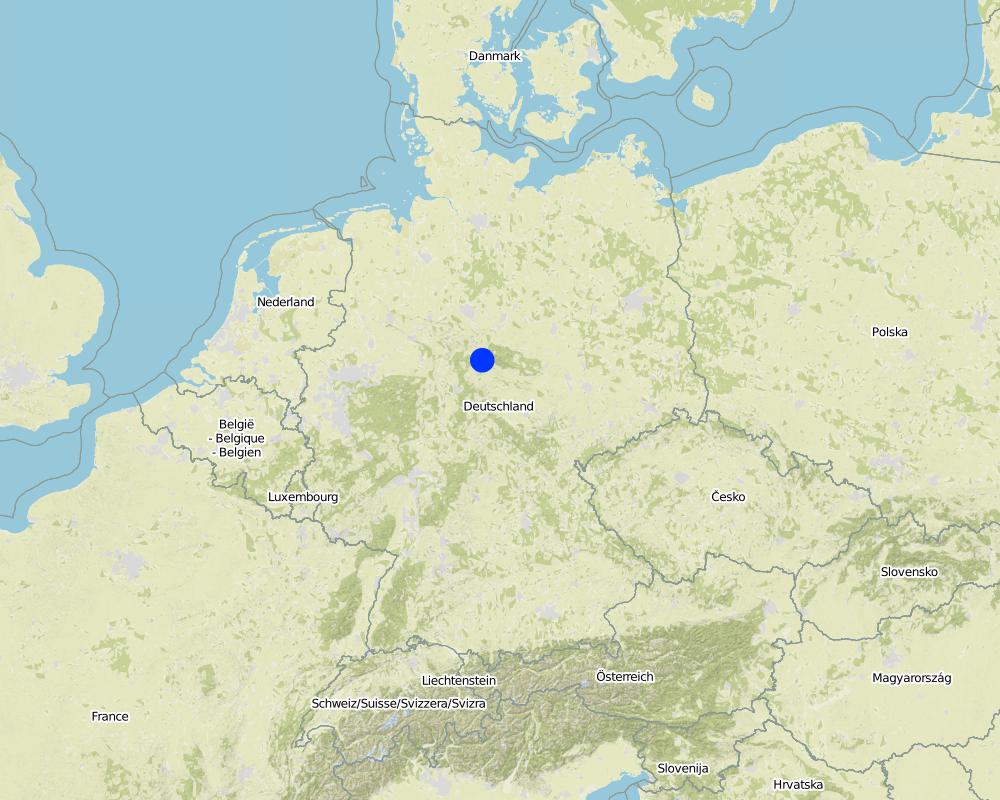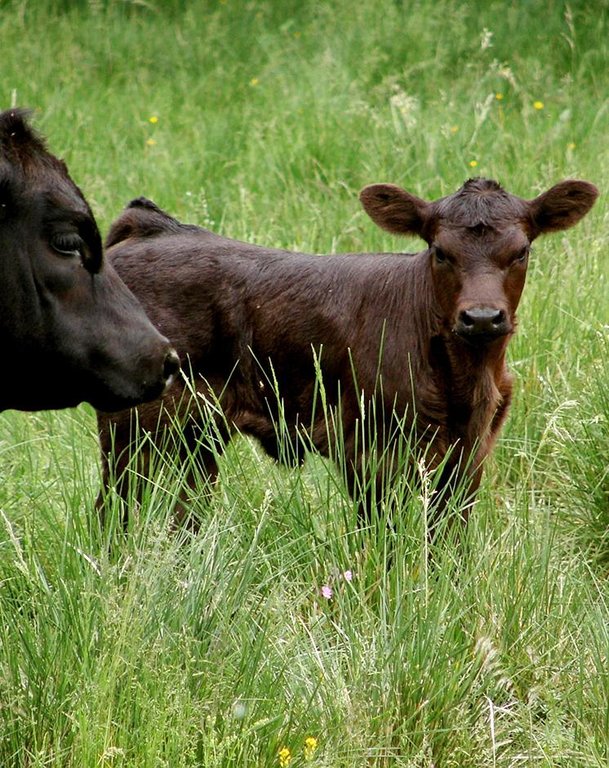Grassland preservation [ប្រទេសអាល្លឺម៉ង់]
- ការបង្កើត៖
- បច្ចុប្បន្នភាព
- អ្នកចងក្រង៖ Johanna Fick
- អ្នកកែសម្រួល៖ –
- អ្នកត្រួតពិនិត្យច្រើនទៀត៖ Fabian Ottiger, Deborah Niggli, Alexandra Gavilano
technologies_1699 - ប្រទេសអាល្លឺម៉ង់
ពិនិត្យមើលគ្រប់ផ្នែក
ពង្រីកមើលទាំងអស់ បង្រួមទាំងអស់1. ព័ត៌មានទូទៅ
1.2 ព័ត៌មានលម្អិតពីបុគ្គលសំខាន់ៗ និងស្ថាប័នដែលចូលរួមក្នុងការវាយតម្លៃ និងចងក្រងឯកសារនៃបច្ចេកទេស
អ្នកជំនាញឯកទេស SLM:
Baum Sarah
Thünen Institute of Rural Studies
ប្រទេសអាល្លឺម៉ង់
ឈ្មោះគម្រោងដែលបានចងក្រងឯកសារ/ វាយតម្លៃលើបច្ចេកទេស (បើទាក់ទង)
Book project: Making sense of research for sustainable land management (GLUES)ឈ្មោះគម្រោងដែលបានចងក្រងឯកសារ/ វាយតម្លៃលើបច្ចេកទេស (បើទាក់ទង)
Climate Change - Land Use Strategies (CC-LandStraD / GLUES)ឈ្មោះអង្គភាពមួយ (ច្រើន) ដែលបានចងក្រងឯកសារ/ វាយតម្លៃបច្ចេកទេស (បើទាក់ទង)
Thünen Institute (Thünen Institute) - ប្រទេសអាល្លឺម៉ង់1.3 លក្ខខណ្ឌទាក់ទងទៅនឹងការប្រើប្រាស់ទិន្នន័យដែលបានចងក្រងតាមរយៈ វ៉ូខេត
អ្នកចងក្រង និង(បុគ្គលសំខាន់ៗ)យល់ព្រមទទួលយកនូវលក្ខខណ្ឌនានាទាក់ទងទៅនឹងការប្រើប្រាស់ទិន្នន័យដែលបានចងក្រងតាមរយៈវ៉ូខេត:
បាទ/ចា៎
1.4 សេចក្តីប្រកាសស្តីពីចីរភាពនៃការពណ៌នាពីបច្ចេកទេស
តើបច្ចេកទេសដែលបានពណ៌នានេះមានបញ្ហាដែលផ្តោតលើការធ្លាក់ចុះគុណភាពដី, បើដូច្នេះវាមិនអាចត្រូវបានប្រកាសថាជាបច្ចេកទេសនៃការគ្រប់គ្រងប្រកបដោយចីរភាពទេ?
ទេ
1.5 ការយោងទៅលើកម្រងបញ្ជីសំណួរ (មួយ ឬច្រើន) នៃវិធីសាស្ត្រផ្សព្វផ្សាយ SLM (ដែលបានចងក្រងដោយទស្សនៈពិភពលោកស្តីពីវិធីសាស្ត្រ និងបច្ចេកទេសងអភិរក្ស WOCAT)
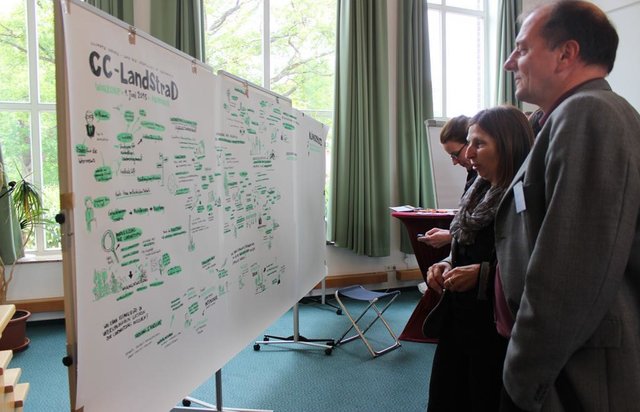
Open dialogue platform on sustainable land management [ប្រទេសអាល្លឺម៉ង់]
Establishing a dialogue platform on sustainable land management which is open to all stakeholders
- អ្នកចងក្រង៖ Johanna Fick
2. ការពណ៌នាពីបច្ចេកទេស SLM
2.1 ការពណ៌នាដោយសង្ខេបពីបច្ចេកទេស
និយមន័យបច្ចេកទេស:
Grassland preservation by the avoidance of ploughing up of grassland and its transformation into cropland
2.2 ការពណ៌នាលម្អិតពីបច្ចេកទេស
ការពណ៌នា:
Increasing demand for food, feed and bioenergy provokes an increased demand for cropland. This leads to intensification of grassland and conversion of e.g. grassland to cropland. By converting grassland to cropland the enhanced mineralization of organic soil matter leads to high emissions of the greenhouse gases CO2 and, in a much lower extent, N2O. the other way around, if cropland is converted to grassland a long-term carbon sink is established that accumulates high amounts of carbon. Nevertheless the conversion of cropland to grassland cannot compensate GHG emissions caused by conversion of grassland to cropland. Due to the soil structure and characteristics C-sequestration in the soil is higher for grassland than for cropland and within the grasslands it is substantially higher for old, humus-rich and boggy sites (e.g. fens or peatbogs) than for young grassland on mineral soils (Schuler et al. 2014). GHG emissions from converting grassland to cropland are more than 12.5 times per areaunit higher for organic than for mineral soils (own calculations after UBA 2014). Avoiding conversion of grassland into cropland avoids on average 10 tCO2-equ/ha*a considering a time-period of ten years (Osterburg et al. 2009).
Purpose of the Technology: The aim of grassland preservation is to avoid/reduce GHG emissions and maintain and develop a carbon sink. Furthermore, grassland habitats have higher biodiversity than croplands and are, in general, less intensively managed. Thus, inputs of fertilizers and pesticides are lower, which is beneficial for water quality regardless of how intensively the grassland is managed. Unlike cropland, grassland is not ploughed or harrowed annually, resulting in better soil protection and a lower risk of erosion; the latter because of the year-round vegetation cover.
Establishment / maintenance activities and inputs: During a research project, the interdependencies between climate change and land use were analysed, and different strategies for sustainable land use management in Germany were modelled. Relevant land use measures which can contribute to the reduction of GHG emissions were evaluated with respect to climate mitigation, bioenergy by biomass, environmental and biodiversity protection (www.cc-landstrad.de). Grassland preservation is one land use practice which showed multiple advantages compared to cropland (after conversion from pasture): these were higher carbon sequestration and lower GHG emissions, better soil protection against erosion, and improved water storage capacity. The disadvantages and thus trade-off of grassland preservation are foregoing production of high-yielding cash crops, higher labour demand per hectare, and lower agricultural income. However, given the importance of preserving carbon stocks accumulated under grassland, the existing pastures should be retained wherever possible. The preservation of grassland is recommended everywhere, but especially for areas with organic soils/peaty soils - as high GHG emissions are the consequence otherwise.
2.3 រូបភាពនៃបច្ចេកទេស
2.5 ប្រទេស/តំបន់/ទីតាំងកន្លែង ដែលបច្ចេកទេសត្រូវបានអនុវត្ត និងបានគ្រប់ដណ្តប់ដោយការវាយតម្លៃនេះ
ប្រទេស:
ប្រទេសអាល្លឺម៉ង់
តំបន់/រដ្ឋ/ខេត្ត:
Germany
បញ្ជាក់បន្ថែមពីលក្ខណៈនៃទីតាំង:
Nationwide
មតិយោបល់:
Total area covered by the SLM Technology is 375000 m2.
Technology is modelled for all agricultural sites in Germany and was not implemented in a precise case.
Boundary points of the Technology area: 54.880451; 8.944112
50.955417; 14.836034
47.483324; 13.013274
47.590007; 7.595230
50.956057; 5.884301
53.567827; 6.999686
Technology is modelled for all agricultural sites in Germany and was not implemented in a precise case.
Map
×2.6 កាលបរិច្ឆេទនៃការអនុវត្ត
ប្រសិនបើមិនច្បាស់ឆ្នាំ សូមបញ្ជាក់កាលបរិច្ឆេទដែលប្រហាក់ប្រហែល:
- 10-50 ឆ្នាំ
2.7 ការណែនាំពីបច្ចេកទេស
សូមបញ្ជាក់តើបច្ចេកទេសត្រូវបានណែនាំឱ្យអនុវត្តដោយរបៀបណា:
- តាមរយៈគម្រោង / អន្តរាគមន៍ពីខាងក្រៅ
មតិយោបល់ (ប្រភេទនៃគម្រោង ។ល។):
Introduction of Cross Compliance (requirement for direct payment) in 2005 in the EU for protection and preservation of grassland
Technology has been refined and increased its significance especially in the past 10 years.
3. ចំណាត់ថ្នាក់នៃបច្ចេកទេស SLM
3.1 គោលបំណងចម្បង (១ ឬច្រើន) នៃបច្ចេកទេសនេះ
- ធ្វើឱ្យប្រសើរឡើងនូវផលិតកម្ម
- កាត់បន្ថយ, បង្ការ, ស្តារឡើងវិញនូវការធ្លាក់ចុះគុណភាពដី
3.2 ប្រភេទដីប្រើប្រាស់មួយប្រភេទ (ច្រើនប្រភេទ) ដែលបានអនុវត្តបច្ចេកទេស

ដីសម្រាប់ចិញ្ចឹមសត្វ
វាលស្មៅធំៗ:
- បែងចែកវាលស្មៅជាប្លុក
ដីវាលស្មៅតូចៗ/ ផលិតកម្មចំណី:
- កាត់ និងជញ្ជូន/ គ្មានវាលស្មៅសម្រាប់ចិញ្ចឹមសត្វ
- បង្កើនវាលស្មៅ
ប្រភេទសត្វ:
- សត្វសេះ
- សត្វចៀម
- cattle
មតិយោបល់:
Major land use problems (compiler’s opinion): Increasing demand for cropland area, and higher income options by cultivating cropland rather than grassland, thus loss of GHGs through conversion.
Major land use problems (land users’ perception): Increasing demand for cropland area. Grassland conversion into cropland might increase the farmer’s income if the soil is suitable for cropping.
Ranching: Cattle, sheep, horses
Cut-and-carry/ zero grazing: Yes
Improved pasture: Yes
Number of growing seasons per year: 1
Longest growing period in days: 235
Livestock density: 50-100 LU /km2
3.5 ក្រុម SLM ដែលបច្ចេកទេសស្ថិតនៅក្នុង
- កាត់បន្ថយការរំខានដល់ដី
- Carbon sink
3.6 វិធានការ SLM ដែលបញ្ចូលនូវបច្ចេកទេស

វិធានការគ្រប់គ្រង
- M2: ការផ្លាស់ប្តូរការគ្រប់គ្រង/ កម្រិតអាំងតង់ស៊ីតេ
3.7 កំណត់ប្រភេទនៃការធ្លាក់ចុះគុណភាពដីសំខាន់ៗដែលបច្ចេកទេសនេះបានដោះស្រាយ

ការហូរច្រោះដីដោយសារទឹក
- Wt: ការបាត់ដីស្រទាប់លើដោយការហូរច្រោះ

ការបាត់ដីដោយសារខ្យល់
- Et: ការបាត់បង់ដីស្រទាប់លើ

ការធ្លាក់ចុះជីវសាស្ត្រនៃដី
- Bc: ការថយចុះនូវគម្របរុក្ខជាតិ
- Bh: ការបាត់បង់ទីជំរក
- Bs: សមាសភាពដែលមានគុណភាពនិងប្រភេទសត្វ/ការថយចុះនូវជីវចម្រុះ
- Bl: ការបាត់បង់មីក្រូ និងម៉ាក្រូសរីរាង្គរបស់ដី

ការបាត់បង់ទឹក
- Ha: ការថយចុះសំណើមដី
- Hp: ការថយចុះគុណភាពទឹកនៅលើផ្ទៃដី
- Hq: ការថយចុះគុណភាពទឹកនៅក្រោមដី
- Hw៖ ការថយចុះសមត្ថភាព buffering របស់តំបន់ដីសើមដែលដោះស្រាយជាមួយនឹងទឹកជំនន់ និងការបំពុល
មតិយោបល់:
Main causes of degradation: soil management (land use change connected with ploughing), crop management (annual, perennial, tree/shrub) (annual), increasing demand for land
3.8 ការពារ កាត់បន្ថយ ឬស្តារឡើងវិញនៃការធ្លាក់ចុះគុណភាពដី
បញ្ជាក់ពីគោលដៅរបស់បច្ចេកទេស ដែលផ្តោតទៅការធ្លាក់ចុះគុណភាពដី:
- ការការពារការធ្លាក់ចុះគុណភាពដី
- ការកាត់បន្ថយការធ្លាក់ចុះគុណភាពដី
4. បច្ចេកទេសជាក់លាក់ សកម្មភាពអនុវត្ត ធាតុចូល និងថ្លៃដើម
4.1 គំនូសបច្ចេកទេសនៃបច្ចេកទេសនេះ
លក្ខណៈពិសេសនៃបច្ចេកទេស (ទាក់ទងនឺងគំនូរបច្ចេកទេស):
Extensive suckler cow husbandry
Location: Arnegger Ried. Ulm, Baden-Wurttemberg, Germany
Date: 30.05.2013
Technical knowledge required for field staff / advisors: low
Technical knowledge required for land users: low
Main technical functions: improvement of ground cover, stabilisation of soil (eg by tree roots against land slides), increase in organic matter
Secondary technical functions: improvement of water quality, buffering / filtering water, reduction in wind speed, promotion of vegetation species and varieties (quality, eg palatable fodder)
ឈ្មោះអ្នកនិពន្ធ:
Norbert Röder, Bundesallee 50, 38116 Braunschweig, Germany
4.5 សកម្មភាពថែទាំ
| សកម្មភាព | ពេលវេលា/ ភាពញឹកញាប់ | |
|---|---|---|
| 1. | The costs depend on the intensity of the management, the more intensive the use the higher the cost (e.g. reseeding etc.) |
4.6 កំណត់ថ្លៃដើមសម្រាប់ការថែទាំ/ សកម្មភាពរបស់បច្ចេកទេស (ក្នុងរយៈពេលមួយឆ្នាំ)
| បញ្ជាក់ពីធាតុចូល | ឯកតា | បរិមាណ | ថ្លៃដើមក្នុងមួយឯកតា | ថ្លៃធាតុចូលសរុប | % នៃថ្លៃដើមដែលចំណាយដោយអ្នកប្រើប្រាស់ដី | |
|---|---|---|---|---|---|---|
| កម្លាំងពលកម្ម | Labour | ha | 1,0 | 135,0 | 135,0 | 100,0 |
| សម្ភារៈ | Machine use | ha | 1,0 | 100,0 | 100,0 | 100,0 |
| សម្ភារៈដាំដុះ | Seeds | ha | 1,0 | 100,0 | 100,0 | 100,0 |
| ថ្លៃដើមសរុបសម្រាប់ការថែទាំដំណាំតាមបច្ចេកទេស | 335,0 | |||||
| ថ្លៃដើមសរុបសម្រាប់ការថែទាំដំណាំតាមបច្ចេកទេសគិតជាដុល្លារ | 335,0 | |||||
4.7 កត្តាសំខាន់បំផុតដែលមានឥទ្ធិពលដល់ការចំណាយ
ពណ៌នាពីកត្តាប៉ះពាល់ចម្បងៗទៅលើថ្លៃដើម:
There are no direct costs if grassland is not converted but managed as before but there might be opportunity costs: If a farmer would convert his grassland to cropland and cultivate arable crops he might have a higher profit than he would have from grassland cultivation.
5. លក្ខណៈបរិស្ថានធម្មជាតិ និងមនុស្ស
5.1 អាកាសធាតុ
បរិមាណទឹកភ្លៀងប្រចាំឆ្នាំ
- < 250 មម
- 251-500 មម
- 501-750 មម
- 751-1,000 មម
- 1,001-1,500 មម
- 1,501-2,000 មម
- 2,001-3,000 មម
- 3,001-4,000 មម
- > 4,000 មម
លក្ខណៈពិសេស/ មតិយោបល់លើរដូវភ្លៀង:
Annual rainfall: 250-500 mm, 500-750 mm, 750-1000 mm, 1000-1500 mm (Annual precipitation for Germany ranges between circa 430-1275mm)
តំបន់កសិអាកាសធាតុ
- សើម
Thermal climate class: temperate
5.2 សណ្ឋានដី
ជម្រាលជាមធ្យម:
- រាបស្មើ (0-2%)
- ជម្រាលតិចតួច (3-5%)
- មធ្យម (6-10%)
- ជម្រាលខ្ពស់បន្តិច (11-15%)
- ទីទួល (16-30%)
- ទីទួលចោត (31-60%)
- ទីទួលចោតខ្លាំង (>60%)
ទម្រង់ដី:
- ខ្ពង់រាប
- កំពូលភ្នំ
- ជម្រាលភ្នំ
- ជម្រាលទួល
- ជម្រាលជើងភ្នំ
- បាតជ្រលងភ្នំ
តំបន់តាមរយៈកម្ពស់ :
- 0-100 ម
- 101-500 ម
- 501-1,000 ម
- 1,001-1,500 ម
- 1,501-2,000 ម
- 2,001-2,500 ម
- 2,501-3,000 ម
- 3,001-4,000 ម
- > 4,000 ម
5.3 ដី
ជម្រៅដីជាមធ្យម:
- រាក់ខ្លាំង (0-20 សម)
- រាក់ (21-50 សម)
- មធ្យម (51-80 សម)
- ជ្រៅ (81-120 សម)
- ជ្រៅខ្លាំង (> 120 សម)
បើអាចសូមភ្ជាប់ការពណ៌នាពីដីឱ្យបានច្បាស់ ឬព័ត៌មានដែលអាចទទួលបាន ឧ. ប្រភេទដី, pH ដី/ ជាតិអាស៊ីត, សមត្ថភាពផ្លាស់ប្តូរកាចុង, វត្តមាននីត្រូសែន, ភាពប្រៃ ។ល។:
Soil depth on average: Very shallow-shallow (Aspects not relevant. Further, grasslands are distributed german-wide and thus conditions are diverse)
Soil texture (Aspects not relevant. Further, grasslands are distributed german-wide and thus conditions are diverse).
Soil fertility (Aspects not relevant. Further, grasslands are distributed german-wide and thus conditions are diverse).
Topsoil organic matter (Aspects not relevant. Further, grasslands are distributed german-wide and thus conditions are diverse).
Soil drainage/infiltration is good
Soil water storage capacity is very high
5.4 ទឹកដែលអាចទាញមកប្រើប្រាស់បាន និងគុណភាពទឹក
នីវ៉ូទឹកក្រោមដី:
< 5 ម
ទឹកលើដីដែលអាចទាញយកប្រើប្រាស់បាន:
ល្អ
គុណភាពទឹក (មិនបានធ្វើប្រត្តិកម្ម):
ទឹកសម្រាប់តែការធ្វើកសិកម្ម (ស្រោចស្រព)
5.5 ជីវៈចម្រុះ
ភាពសម្បូរបែបនៃប្រភេទ:
- ខ្ពស់
មតិយោបល់ និងលក្ខណៈពិសេសផ្សេងទៀតលើជីវចម្រុះ:
Especially extensive grassland is species rich and contains rare and specialized species
5.6 លក្ខណៈនៃអ្នកប្រើប្រាស់ដីដែលអនុវត្តបច្ចេកទេស
ទីផ្សារនៃប្រព័ន្ធផលិតកម្ម:
- ពាណិជ្ជកម្ម/ ទីផ្សារ
ឯកជន ឬក្រុម:
- ធ្វើខ្លួនឯង/ គ្រួសារ
យេនឌ័រ:
- ស្ត្រី
- បុរស
សូមបញ្ជាក់ពីលក្ខណៈពាក់ព័ន្ធផ្សេងទៀតអំពីអ្នកប្រើប្រាស់ដី:
Land users applying the Technology are mainly common / average land users
Population density: 200-500 persons/km2
Annual population growth: < 0.5%
Market orientation of production system: nature conservation
5.7 ទំហំផ្ទៃដីជាមធ្យមនៃដីប្រើប្រាស់ដោយអ្នកប្រើប្រាស់ដី ក្នុងការអនុវត្តបច្ចេកទេស
- < 0.5 ហិកតា
- 0.5-1 ហិកតា
- 1-2 ហិកតា
- 2-5 ហិកតា
- 5-15 ហិកតា
- 15-50 ហិកតា
- 50-100 ហិកតា
- 100-500 ហិកតា
- 500-1,000 ហិកតា
- 1,000-10,000 ហិកតា
- > 10,000 ហិកតា
មតិយោបល់:
Average area of land owned or leased by land users applying the Technology: 5-15 ha, 5-15 ha, 15-50 ha
Size of cropland per household:
Grassland 4.700.000 ha, houshould 40.200.000
Size of grazing land per household: farms 300.000 grassland 4.700.000 ha
5.8 ភាពជាម្ចាស់ដី កម្មសិទ្ធប្រើប្រាស់ដី និងកម្មសិទ្ធប្រើប្រាស់ទឹក
ភាពជាម្ចាស់ដី:
- ឯកជន មិនមានកម្មសិទ្ធ
- NGO
កម្មសិទ្ធិប្រើប្រាស់ដី:
- ឯកជន
មតិយោបល់:
human environment: Grassland per household: Grassland 4.700.000 ha, farms 300.000
6. ផលប៉ះពាល់ និងការសន្និដ្ឋាន
6.1 ផលប៉ះពាល់ក្នុងបរិវេណអនុវត្តបច្ចេកទេសដែលកើតមាន
ផលប៉ះពាល់លើសេដ្ឋកិច្ចសង្គម
ផលិតផល
ផលិតកម្មដំណាំ
ភាពសម្បូរបែបនៃផលិតផល
ទឹកដែលអាចទាញមកប្រើប្រាស់បាន និងគុណភាពទឹក
ទឹកបរិភោគដែលអាចទាញយកមកប្រើប្រាស់បាន
មតិយោបល់/ ការបញ្ជាក់:
In areas with low precipitation
គុណភាពទឹកបរិភោគ
មតិយោបល់/ ការបញ្ជាក់:
In areas with low precipitation
តម្រូវការទឹកសម្រាប់ស្រោចស្រព
មតិយោបល់/ ការបញ្ជាក់:
perhaps
ចំណូល និងថ្លៃដើម
ការចំណាយលើធាតុចូលកសិកម្ម
មតិយោបល់/ ការបញ្ជាក់:
Yes
ចំណូលក្នុងកសិដ្ឋាន
បន្ទុកការងារ
ផលប៉ះពាល់ទៅលើវប្បធម៌សង្គម
ឱកាសនៃការបង្កើតថ្មី
Improved livelihoods and human well-being
មតិយោបល់/ ការបញ្ជាក់:
Disadvantages will realised if grassland preservation won't be done.
ផលប៉ះពាល់ទៅលើអេកូឡូស៊ី
វដ្តទឹក/លំហូរ
គុណភាពទឹក
មតិយោបល់/ ការបញ្ជាក់:
Yes: Due to fertilization, pesticides
លំហូរទឹកលើផ្ទៃដី
ដី
សំណើមដី
គម្របដី
ការបាត់បង់ដី
ដីប្រេះ
ដីហាប់
វដ្តនៃសារធាតុចិញ្ចឹម/ការទទួលបាន
សារធាតុសរីរាង្គដី/ការបូនក្រោមដី
ជីវចម្រុះ៖ ដំណាំ, សត្វ
ភាពសម្បូរបែបនៃរុក្ខជាតិ
ប្រភេទសត្វមានប្រយោជន៍
ភាពសម្បូរបែបនៃទីជំរក
ការកាត់បន្ថយហានិភ័យនៃគ្រោះមហន្តរាយ និងគ្រោះអាកាសធាតុ
ការបំភាយនៃកាបូន និងឧស្ម័នផ្ទះកញ្ចក់
ផលប៉ះពាល់ទៅលើអេកូឡូស៊ីផ្សេងៗ
Hazard towards adverse events
6.2 ផលប៉ះពាល់ក្រៅបរិវេណអនុវត្តបច្ចេកទេសដែលកើតមាន
ខ្យល់នាំយកនូវធូរលី
6.3 ភាពប្រឈម និងភាពរួសនៃបច្ចេកទេសទៅនឹងការប្រែប្រួលអាកាសធាតុ និងគ្រោះអាកាសធាតុ/ គ្រោះមហន្តរាយ (ដែលដឹងដោយអ្នកប្រើប្រាស់ដី)
ការប្រែប្រួលអាកាសធាតុ
ការប្រែប្រួលអាកាសធាតុ
| រដូវកាល | កើនឡើង ឬថយចុះ | លក្ខណៈឆ្លើយតបនៃបច្ចេកទេសទៅនឹងការប្រែប្រួលអាកាសធាតុ | |
|---|---|---|---|
| សីតុណ្ហភាពប្រចាំឆ្នាំ | កើនឡើង | ល្អ |
គ្រោះអាកាសធាតុ (មហន្តរាយ)
គ្រោះមហន្តរាយធម្មជាតិ
| លក្ខណៈឆ្លើយតបនៃបច្ចេកទេសទៅនឹងការប្រែប្រួលអាកាសធាតុ | |
|---|---|
| ព្យុះភ្លៀងតាមតំបន់ | ល្អ |
| ព្យុះកំបុតត្បូងតាមតំបន់ | ល្អ |
គ្រោះមហន្តរាយអាកាសធាតុ
| លក្ខណៈឆ្លើយតបនៃបច្ចេកទេសទៅនឹងការប្រែប្រួលអាកាសធាតុ | |
|---|---|
| រាំងស្ងួត | ល្អ |
គ្រោះមហន្តរាយទឹក
| លក្ខណៈឆ្លើយតបនៃបច្ចេកទេសទៅនឹងការប្រែប្រួលអាកាសធាតុ | |
|---|---|
| ទឹកជំនន់ទូទៅ (ទន្លេ) | ល្អ |
ផលវិបាកដែលទាក់ទងនឹងបរិយាកាសផ្សេងៗទៀត
ផលវិបាកដែលទាក់ទងនឹងបរិយាកាសផ្សេងៗទៀត
| លក្ខណៈឆ្លើយតបនៃបច្ចេកទេសទៅនឹងការប្រែប្រួលអាកាសធាតុ | |
|---|---|
| កាត់បន្ថយពេលដាំដុះ | ល្អ |
6.4 ការវិភាគថ្លៃដើម និងអត្ថប្រយោជន៍
តើផលចំណេញ និងថ្លៃដើមត្រូវបានប្រៀបធៀបគ្នាយ៉ាងដូចម្តេច (ទស្សនៈរបស់អ្នកប្រើប្រាស់ដី)?
រយៈពេលខ្លី:
អវិជ្ជមាន
រយៈពេលវែង:
អវិជ្ជមាន
តើផលចំណេញ និងការថែទាំ/ ជួសជុលត្រូវបានប្រៀបធៀបគ្នាយ៉ាងដូចម្តេច (ទស្សនៈរបស់អ្នកប្រើប្រាស់ដី)?
រយៈពេលខ្លី:
អវិជ្ជមាន
រយៈពេលវែង:
អវិជ្ជមានខ្លាំង
មតិយោបល់:
main cost are opportunity cost of arable land use, they occur yearly.
6.5 ការទទួលយកបច្ចេកទេស
មតិយោបល់:
There is a strong trend towards spontaneous adoption of the Technology
Comments on adoption trend: Within the Common Agricultural Policy of the EU reform grassland protection is enhanced since 1 January 2015. In Germany the conversion of grassland is subject to approval and in general only permitted if the same area converted is established as grassland in the same region.
6.7 ភាពខ្លាំង/ គុណសម្បត្តិ/ ឱកាសនៃបច្ចេកទេស
| ភាពខ្លាំង/ គុណសម្បត្តិ/ ឱកាសនៅកន្លែងរបស់អ្នកប្រើប្រាស់ដី |
|---|
| Conservation/restoration of regional typically landscapes. |
| ភាពខ្លាំង/ គុណសម្បត្តិ/ ឱកាស ទស្សនៈរបស់បុគ្គលសំខាន់ៗ |
|---|
| By avoiding conversion of grassland to cropland huge amounts of GHG emissions can be avoided. Further advantages are a lower risk of soil erosion, possible flood prevention, lower levels of fertilizers and pesticides leaching into runoff waters, and higher biodiversity conservation. |
6.8 ភាពខ្សោយ/ គុណវិបត្តិ/ ហានិភ័យនៃបច្ចេកទេស និងវិធីសាស្ត្រដោះស្រាយ
| ភាពខ្សោយ/ គុណវិបត្តិ/ ហានិភ័យ ទស្សនៈរបស់អ្នកប្រើប្រាស់ដី | តើបច្ចេកទេសទាំងនោះបានដោះស្រាយបញ្ហាដូចម្តេច? |
|---|---|
| The income from grassland might – if location factors like soil, water availability are suitable – be lower than it would be for cropland. Thus, there can be high opportunity costs of preserving grassland. | Grassland preservation can be enhanced by legal restrictions. Financial incentives for land users make grassland preservation more attractive from an economical point of view. |
7. ឯកសារយោង និងវេបសាយ
7.1 វិធីសាស្ត្រ/ ប្រភពនៃព័ត៌មាន
- តាមការចុះទីវាល ការស្រាវជ្រាវនៅទីវាល
- ការសម្ភាសន៍ជាមួយអ្នកប្រើប្រាស់ដី
តើពេលណាដែលទិន្នន័យបានចងក្រង (នៅទីវាល)?
29/07/2015
7.2 ឯកសារយោងដែលបានចេញផ្សាយ
ចំណងជើង អ្នកនិពន្ធ ឆ្នាំ ISBN:
UBA (2014)
មានប្រភពមកពីណា? ថ្លៃដើមប៉ុន្មាន?
http://www.umweltbundesamt.de/publikationen/schwerpunkte-2014
ចំណងជើង អ្នកនិពន្ធ ឆ្នាំ ISBN:
Osterburg B et al. (2009) Erfassung, Bewertung und Minderung von Treibhausgasemissionen des deutschen Agrar- und Ernährungssektors.
មានប្រភពមកពីណា? ថ្លៃដើមប៉ុន្មាន?
Studie im Auftrag des Bundesministeriums für Ernährung, Landwirtschaft und Verbraucherschutz. Arbeitsberichte aus der vTI-Agrarökonomie 2009/03, Braunschweig, Hamburg, Trenthorst
ចំណងជើង អ្នកនិពន្ធ ឆ្នាំ ISBN:
Schuler J et al. (2014) Instrumente zur Stärkung von Synergien zwischen Natur- und Klimaschutz im Bereich Landbewirtschaftung
មានប្រភពមកពីណា? ថ្លៃដើមប៉ុន្មាន?
BfN-Skripten, pp. 187. Bonn, Bad Godesberg
មានប្រភពមកពីណា? ថ្លៃដើមប៉ុន្មាន?
http://www.umweltbundesamt.de/publikationen/berichterstattung-unter-der-klimarahmenkonvention
មានប្រភពមកពីណា? ថ្លៃដើមប៉ុន្មាន?
http://www.umweltbundesamt.de/publikationen/berichterstattung-unter-der-klimarahmenkonvention
7.3 ការភ្ជាប់ទៅកាន់ព័ត៌មានពាក់ព័ន្ធលើប្រព័ន្ធអនឡាញ
វេបសាយ:
http://www.umweltbundesamt.de/publikationen/submission-under-the-united-nations-framework
ការតភ្ជាប់ និងម៉ូឌុល
ពង្រីកមើលទាំងអស់ បង្រួមទាំងអស់ការតភ្ជាប់

Open dialogue platform on sustainable land management [ប្រទេសអាល្លឺម៉ង់]
Establishing a dialogue platform on sustainable land management which is open to all stakeholders
- អ្នកចងក្រង៖ Johanna Fick
ម៉ូឌុល
គ្មានម៉ូឌុល


